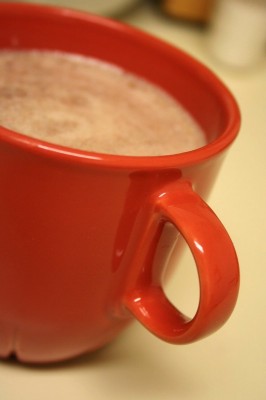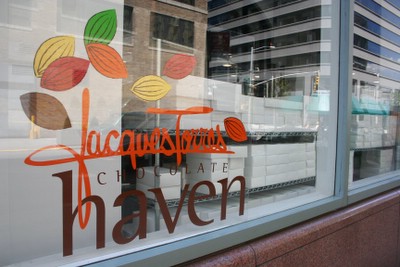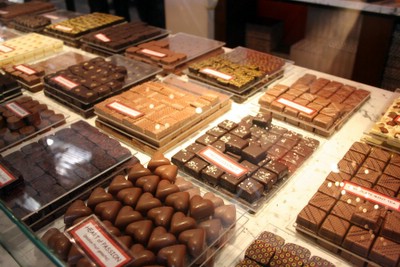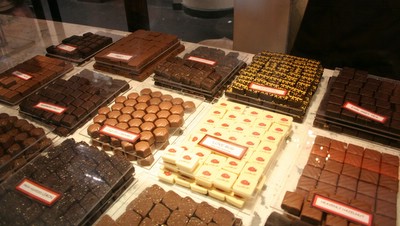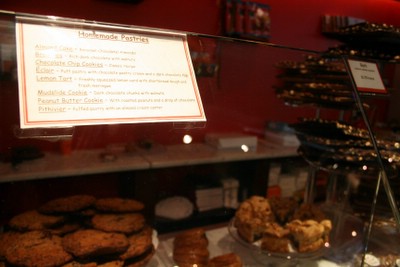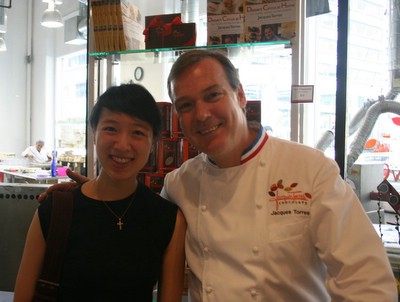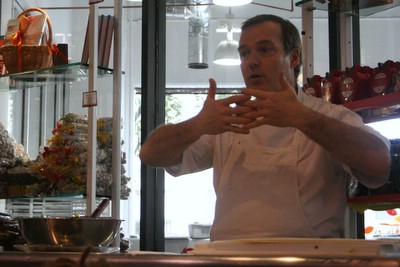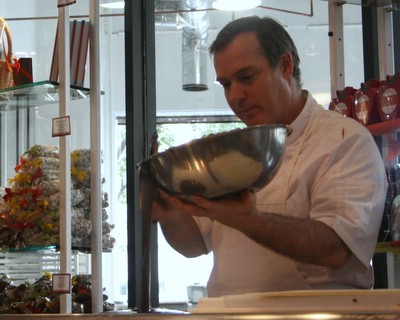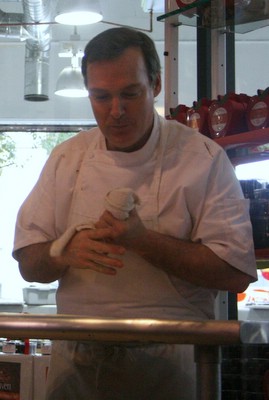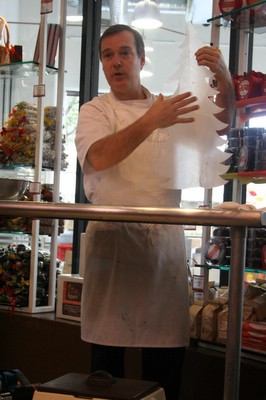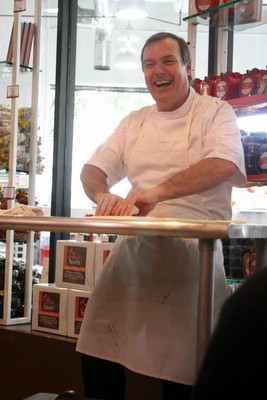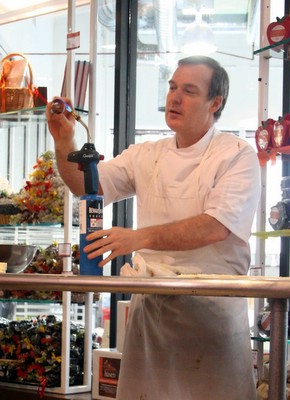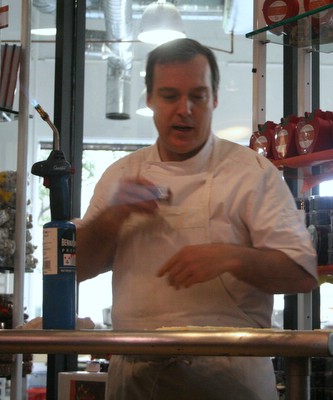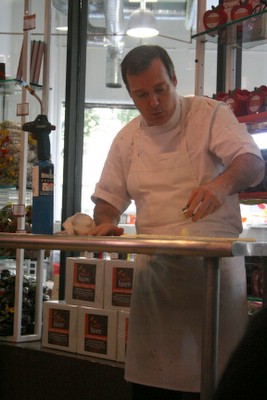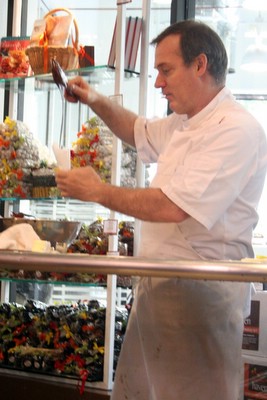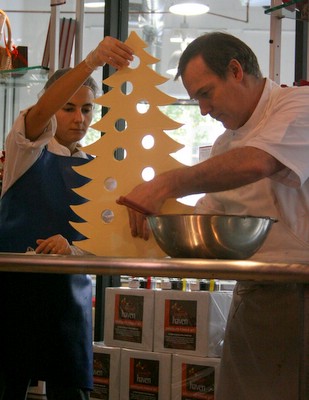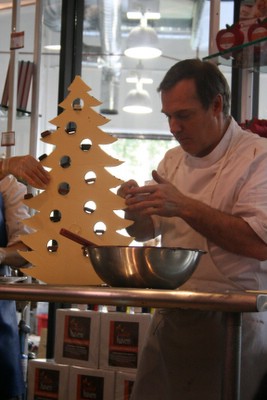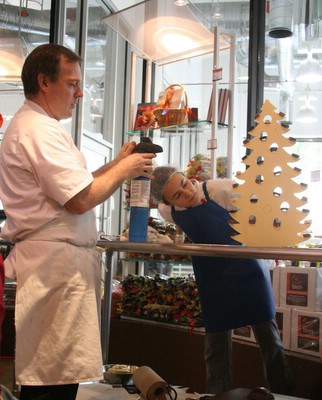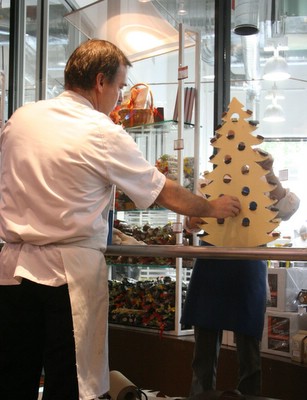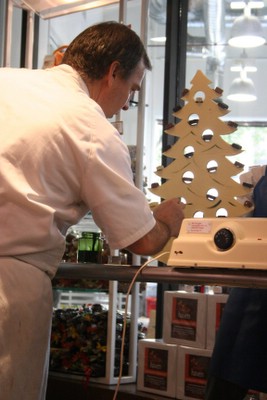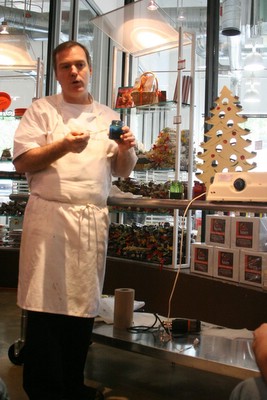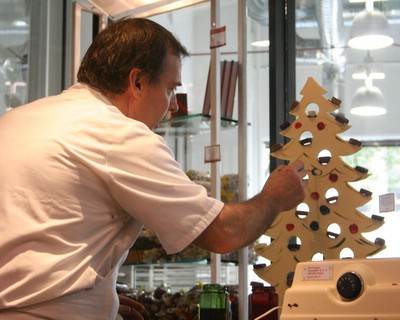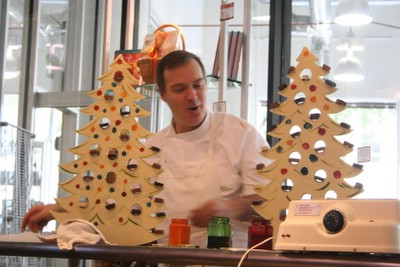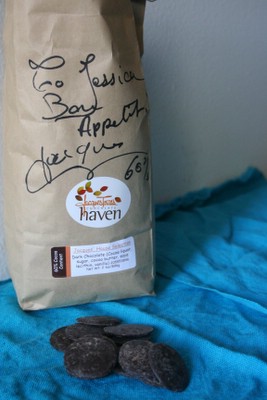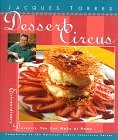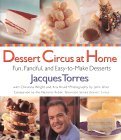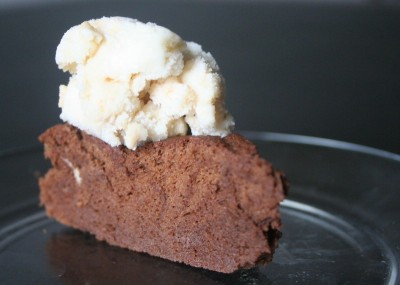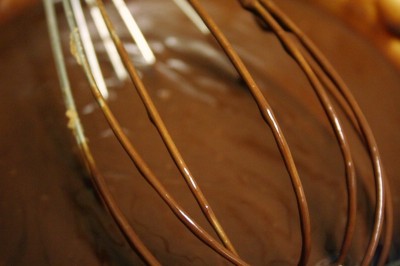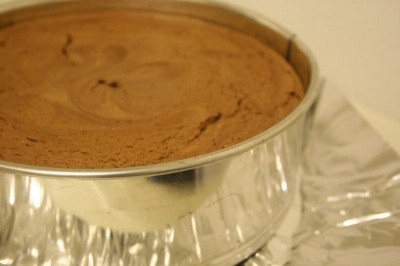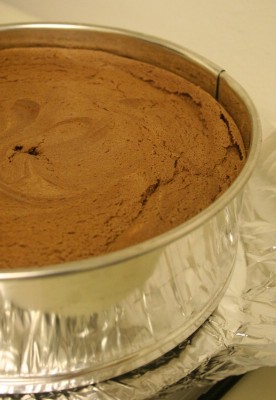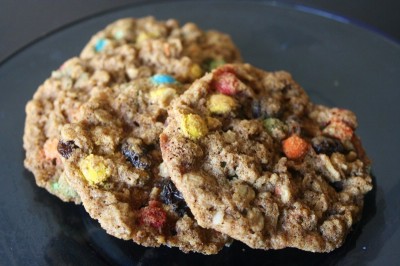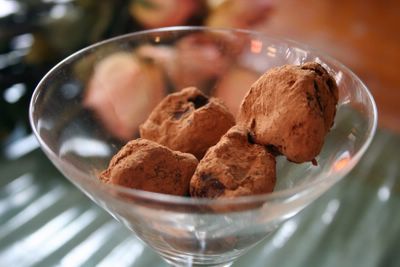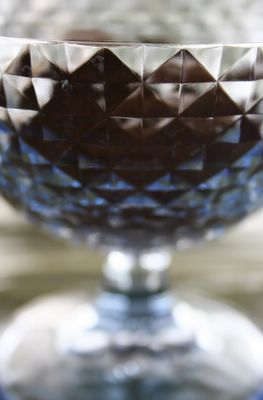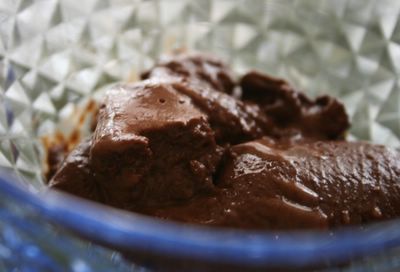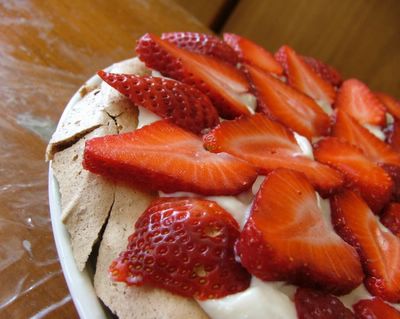Homemade Chocolate-Hazelnut Spread Recipe (Better Than Nutella)
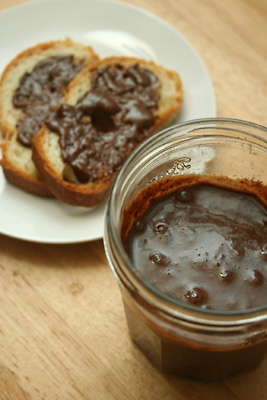
If someone offered you portable chocolate that could instantly be spread on bread, fruit, crackers and pastries, how could you refuse? Thus began my love affair with Nutella, a European spread made of hazelnut butter and cocoa.
During my days at NYU, I was at a make-your-own sandwich bar when I first tried Nutella with French bread. What a revelation! The chocolate oozed out of the nooks and crannies, while the spread’s smoothness contrasted the bread’s crust. I then saw that bagels were an excellent vehicle for Nutella. So were pretzels. And bananas. And gummy bears.
Fascinated by this new condiment, I bought myself a jar and finished it in one week. I’ve never met any food that does not taste better with a dollop of Nutella. Sometimes the best way to enjoy Nutella is to take a spoonful and just plop it in your mouth.
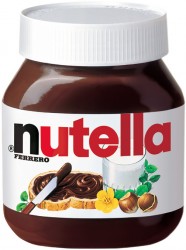
According to Ferrero’s website, Nutella was created in the 1940s in the midst of a chocolate shortage. Pietro Ferrero, a pastry maker, stretched chocolate by thinning it out with ground hazelnuts. It became so popular that it’s as ubiquitous in Europe as peanut butter is in the U.S. If you ignore the high sugar content, Nutella actually has a nutritional profile similar to peanut butter. Its fat comes from the nuts, not the chocolate (Nutella gets its flavor from cocoa solids rather than cocoa butter). True, nuts are high in fat. But if you’re going to be eating fat, it might as well come from nuts rather than steaks.
According to Mort Rosenblum’s Chocolate: A Bittersweet Saga of Dark and Light, a 13-ounce jar of Nutella contains 50 (2/3 cup) hazelnuts, 1 1/2 cups skim milk, “enough cocoa to make it brown, and a lot of sugar.” As much as I love Nutella, today’s commercial version is actually sugar that’s flavored with hazelnuts and cocoa. You can tell because sugar is first in the ingredient list. And there’s lots of added oil to make it spreadable.
The version that I make at home is truly chocolate-flavored hazelnut butter: I use 2 cups of hazelnuts rather than Ferrero’s puny 2/3 cup. This recipe is the same that I’ve sent out in Blogging by Mail and that Nic (of The Baking Sheet) used for her Nutella biscotti.
If you love this original recipe and repost it, please credit this site. Technically, recipes aren’t copyrightable, but the L.A. Times posted an eerily similar version.
Update: For an even richer version, try the second formula, which has caramel powder and no added oil. Unless you have a professional nut grinder, it won’t be as smooth as commercial Nutella, but the flavor more than makes up for it.
Chocolate-Hazelnut Spread (easy version)
Yield: about 12 ounces (1 1/2 cups)
2 cups whole raw hazelnuts
1 cup powdered sugar
1/4 cup unsweetened cocoa powder
up to 1/4 cup vegetable or nut oil
1/2 tsp vanilla extract
- Preheat oven to 350° F. Place hazelnuts in a single layer on a shallow baking pan. Toast until the skins are almost black and the meat is dark brown, about 15 minutes. Stir the nuts halfway through baking to ensure an even color.
- To get rid of the bitter skins, wrap the cooled hazelnuts in a clean kitchen towel or paper towel. Rub until most of the skins come off, but don’t worry if some remain.
- Process nuts in a food processor, scraping down the sides of the bowl occasionally, until they have liquefied, about 5 minutes. First, you will get coarsely chopped nuts, then a fine meal. After a little while, the nuts will form a ball around the blade, and it will seem like you only have a solid mass. Keep processing. The heat and friction will extract the natural oils, and you will get hazelnut butter!
- When the nuts have liquified, add the sugar, cocoa and vanilla. Slowly drizzle in enough oil to make a spreadable consistency. Since the mixture is warm, it will be more fluid now than at room temperature.
- Transfer the spread to an airtight container, and store in the refrigerator for 1-2 months. For best results, stir the chocolate-hazelnut spread before using.
Variations: To make any standard nut butter, use this procedure but omit the powdered sugar, cocoa, vanilla and extra oil. Add 1/2 tsp salt and up to 2 tbsp granulated sugar. Try making your own cashew butter: you may never go back to peanut butter again!
Chocolate-Hazelnut Spread (caramel base)
While this version requires a little more work, it has a richer, more sophisticated flavor.
Caramel instructions adapted from Chocolate and the Art of Low-Fat Desserts by Alice Medrich
Yield: about 12 ounces (1 1/2 cups)
Caramel:
1/2 cup sugar
1/4 cup water
Hazelnut Butter:
2 cups whole raw hazelnuts
1/4 cup unsweetened cocoa powder
1/2 tsp vanilla extract
1/8 tsp salt
- Preparation: Preheat oven to 350° F. Line a baking sheet with foil.
- Make the caramel: Combine the sugar and water in a 3- to 4-cup saucepan. To prevent crystallization, don’t stir it again during the cooking. Cover and bring the mixture to a simmer over medium heat. Remove the lid and wipe down the sides of the pan with a wet pastry brush or a scrunched up paper towel dipped in water. Cover and cook for 2 minutes, or until the sugar’s completely dissolved. Uncover and cook until the syrup looks like pale amber maple syrup. If your pan’s dark and you can’t gauge the color of the syrup, spoon a drop or two onto a white saucer. Swirl the pan gently, continuing to cook and test the color until the syrup turns medium amber.
- Immediately pour the caramel onto the lined baking sheet. Tilt the sheet to spread the caramel as thinly as possible. Let harden completely, about 15 minutes.
- Toast the nuts: Meanwhile, place the hazelnuts in a single layer on another baking sheet. Toast in the oven until the skins are almost black and the meat is dark brown, about 15 minutes. Stir the nuts halfway through baking to ensure an even color.
- To get rid of the bitter skins, wrap the cooled hazelnuts in a clean kitchen towel or paper towel. Rub until most of the skins come off, but don’t worry if some remain.
- Make the hazelnut butter: When the caramel is completely cool, break it into small pieces and pulverize in a food processor. Try to get the caramel as fine as possible at this stage (it won’t get finer once you add the nuts).
- Add the nuts and process until they have liquefied, about 5 minutes. Scrape down the sides of the bowl occasionally. Be patient; the nuts will go from a fine meal, to forming a ball around the blade, to nut butter. Add the cocoa, vanilla and salt and process until smooth.
- Transfer the spread to an airtight container, and store in the refrigerator for 1-2 months. For best results, stir the chocolate-hazelnut spread before using.
Notes:
- Please use whole raw nuts, and toast them yourself to intensify the flavor. Pre-toasted or pre-chopped nuts are often spoiled.
- To further intensify the nut flavor, use unrefined nut oil (for version 1), which is tan in color. Peanut oil is especially cheap in Chinese supermarkets: 20 ounces for $2.38! So if you’re looking for a “gourmet” ingredient, try an ethnic market.
- You really need a full-sized food processor to make nut butter, not a mini version or a blender. I recommend a 7-cup Cuisinart: it’s large enough for most household tasks but isn’t too bulky.
Resources:
Official Nutella site
Nutella recipes







